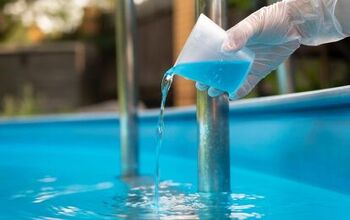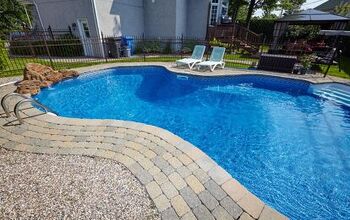How Much Bleach To Add To A Pool? (Find Out Now!)

Anyone who’s ever bathed in a poorly-maintained pool will tell you that an unsanitary pool is a serious threat to your health. That’s why most new pool owners tend to delve deep into their pool maintenance research. One of the more difficult issues to discuss is the topic of adding bleach to a pool in order to keep it sanitary. So, how much is enough…and how much is too much?
You need to add enough bleach to raise the chlorine levels of your pool to 1 to 3 ppm. If you’re trying to shock your pool, then you will need to add 1/2 gallon per 10,000 gallons of pool water to raise it to 5 ppm. On the other hand, if you are just raising your chlorine levels, 1/4 gallon per 10,000 gallons will suffice.
There’s a lot of math that’s involved in figuring out your specific bleach needs, not to mention important tips to ensure the safety of your swimmers. Before you pour that bleach, make sure to read our guide on the topic.
Do You a Need Pool, Spa, or Hot Tub Contractor?
Get free, zero-commitment quotes from pro contractors near you.

Why Should You Add Bleach To A Pool?
Most people are aware that adding chlorine, much like those found in pool shock kits, will raise your pool’s pH well and potentially kill bacteria and mold. What you may not realize is that many of the cleaning products that feature chlorine have too many stabilizers in them to effectively kill bacteria quickly. Bleach will keep your pool water crystal clear.
Much like the way you need to shock a hot tub, pools need to have the bacterial buildup in them killed off. Otherwise, the water in the pool will become too dangerous for people to swim in.
How Do You Calculate How Many Gallons Of Pool Water You Have?
Before you dump a bunch of bleach in your pool, you need to be aware of how many gallons you have. This will require you to follow a formula. Here’s how to calculate it out:
- Start by multiplying the length by the width and the depth of your pool. If you have a pool that varies in-depth, just take the average, and use that number for the calculation.
- Then, multiply this number by the “shape factor.” Refer to the list below to figure out what your factor is.
If you have a round pool, multiply your number by 5.9.Or, if you have an oval pool, multiply it by 6.7.If you are like most people and have a rectangular pool, multiply it by 7.5.
- The final result tells you how many gallons your pool holds. You can use this as a measuring stick for how much bleach you need to pour in.
What Do You Do Now?
Once you have the number of gallons your pool has, you use the ratio provided at the start of this article to determine how much bleach you will need to add. (Reminder: It’ll either be 1/2 gallon or 1/4 gallon for every 10,000 gallons of pool water, depending on whether you want to shock the pool or just balance out chlorine levels.)
If you regularly use a 12 percent chlorine solution to shock or clean your pool, there’s another shortcut you can use. Since the chlorine levels are twice as high in chlorine solutions used in pools, you can just use half the amount you would with a chlorine shock.
What’s The Proper Way To Add Bleach To Your Pool?
The best way to add bleach to your pool is to do so by mixing it with some water first and then pouring it into your pool over the course of several minutes. While you’re adding bleach, make sure to test the chlorine levels of the pool using a chlorine test kit. This way, you’ll ensure that you don’t need to worry about over-chlorinating your pool.
After that, you will need to use a small amount of stabilizing agent to ensure that your bleach doesn’t become too much for the pool water to handle. You can pick this up at the local pool supply store.
What Kind Of Bleach Should You Use?
While many people tend to assume that you need a fancy bleach solution to do this job, the truth is far simpler. A regular jug of Clorox, much like what you would use for cleaning tile or getting rid of mold in shower caulk, will work fine. You should aim to get bleach that has a 5.7 to 6 percent concentration or so.
With that said, many people believe it’s better to use pool-grade chlorine bleach when you’re balancing out your pool.
How Often Do You Need To Add Bleach To Your Pool?
There’s no solid schedule you should set for bleaching your pool, simply because different pools will need different schedules. The best thing you can do is check your chlorine levels two to three times per week and adjust the levels as needed. If you notice any of the following signs, adding bleach may be a good idea:
- If you notice your pool becoming cloudy, green, or otherwise murky, you need bleach. All three warning signs suggest that you have an overgrowth of bacteria. Should bacteria be growing out of control, you need to add bleach to counteract that growth.
- You should add bleach when your pool becomes too acidic. Bleach is the easiest way to increase the pH levels, all while preventing water clarity problems.
- If you check your pool’s chlorine levels and find them low, you should add more bleach. This should be common sense, of course, but it still deserves to be said. If you notice your stats slipping, you need to make sure that your pool doesn’t fall into neglect.
- Any time that you need to shock your pool should be a time to bring out the bleach. Many pool owners have their own shock schedules, and if you have one, then you need to make sure to abide by them. With shocking your pool, bleach is going to have to be used in most cases.
- Whenever your pool has not seen a lot of action, you will need to add a little more bleach. Inactivity makes it easy for bacteria to grow. That’s why most pools will need a bleaching session after a month of disuse.
- Pool parties can also result in a need to bleach. Pools are pretty simple when it comes to their demands. If you have a party where tons of people splashed, you’re dealing with a lot more bacteria than if you just had two or three bathing in it. This may require a chlorine session.
Are There Any Alternatives To Bleach You Can Use?
If you’re skittish about using bleach, you can reduce (but not eliminate) the amount of bleach by using pool bromine, ionizers, or ozonators. If you want to remove chlorine from the equation altogether, you can use PMBB. However, bleach remains the most affordable and effective way to clean a pool. That’s why it’s so popular.
Do You a Need Pool, Spa, or Hot Tub Contractor?
Get free, zero-commitment quotes from pro contractors near you.

Related Questions
Can you use salt as an alternative to chlorine in a pool?
Believe it or not, using high levels of salt can be a sufficient way to kill off most bacteria. However, there are still caveats to this method. You may have a higher maintenance level. Salt may not be able to kill all the pests in your pool, but it will be able to get rid of most of the bacteria. A salt pool is a safe pool.
How long can water sit in a pool without adding chlorine?
Water can get toxic pretty quickly after it’s been sitting without chlorine. Experts agree that water will turn dangerous if it’s sat for longer than 24 to 48 hours without using chlorine.

Ossiana Tepfenhart is an expert writer, focusing on interior design and general home tips. Writing is her life, and it's what she does best. Her interests include art and real estate investments.
More by Ossiana Tepfenhart



























